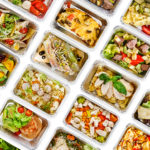
How to Unlock the Food Marketing Potential of Meal Kits
It’s no secret that meal delivery kits are big business. According to Statista, the fresh-food meal kit delivery market is valued at $4.65 billion and expected to reach $11 billion in 2022. They are grabbing the attention of male shoppers, busy families, Millennials and GenXers who are 3 times more than likely to try them than other generations.
Today’s consumers are curious, adventurous, and craving new food experiences closer to home which has the meal kit market buzzing with opportunity. With stats like this, I wondered, how can a food marketing agency leverage meal kits to meet the marketing and business objectives of our food brand and food commodity clients?
My Meal Kit Experiment
Wanting to better understand the appeal, experience and options meal kits provide, I committed myself to a 2-month, hands-on trial. Trying each service for a minimum of 2 weeks, I selected 5 providers including Blue Apron, HelloFresh, HomeChef, Sun Basket and Daily Harvest. To garner useful food marketing insights, I made it a point to experience each delivery service through the lens of the consumer.
As we all know, consistently following a healthy diet isn’t always easy. It can take a lot of time and energy and I craved something beyond my nightly trip to the Whole Foods salad bar. I’d always been intrigued by delivery services. But with all the promotional offers flying at me, I didn’t know where to start.
Overall, it was a great experience. I loved discovering new ingredients and usage applications. For example, I learned that Tempeh (an ingredient I never in a million years thought to try), made for a relatively easy and delicious plant-based substitute in a Bolognese sauce. Or adding pickled onion and roasted chayote to my Mexican dishes kicked them up a notch. And, my late Italian great-grandma would have been very proud to know I mastered the art of making risotto.
As a food marketing pro, it was easy to see opportunities within the meal kit space for food brands and food commodities. I also gained insight into some of the challenges facing meal kit services when it comes to customer retention.
 Customization is Key
Customization is Key
One of the allures of meal kits is the ability to easily adopt a highly specific diet. It took me some time to find the best option for my dietary goals. Kits like Blue Apron and HelloFresh offered more generic plans versus the more customizable options found with Home Chef, Sun Basket, and Daily Harvest. For example, HelloFresh offers only 2 menu options – a Vegetarian or a Classic plan with limited flexibility. On the other hand, Sun Basket offers several options including Paleo, Gluten-Free, Vegetarian, and seasonal plans which made me more inclined to continue my subscription.
A consumer is more likely to stick with a meal kit long-term if the dietary offerings align with their personal goals. So, for a long-term food marketing partnership, customization is key.
Convenience is King
My biggest challenge was the time it took to prepare and cook a meal. Most took about 40 minutes, not including clean-up. At the end of the week, my busy schedule and limited time lead to deconstructed meal kits, discarded perishables and random dry goods in my pantry. This baffled me. How could something designed to be convenient, seem at times, inconvenient?
According to the USDA, Americans over the age of 18 spend an average of 37 minutes to prep, cook and clean one meal. For Millennials, it’s 21 minutes. If a meal kit intends to captivate the attention of the consumer, it must make cooking easier. Doing so will keep subscriptions going well past the initial discovery and excitement phase.
The good news is providers are learning and adjusting their plans to meet demand. Take HomeChef for example, they just came out with 5-minute salads. With Daily Harvest, you just add water into the packaging. And HelloFresh has just announced plans for ready-to-eat meals.
Taking this one step further, new partnerships with grocers make meal kits more appealing to the subscription-phobic consumer. According to Nielsen, meal kits in U.S. grocery stores generated more than $80 million in sales, up 6.7% YOY. With more than one-third of consumers now looking to purchase meal kits at retail, grocery stores have an opportunity to assemble meals at a more affordable price. This opens the door even wider for retail partnerships between meal kits and food marketers.
Brand Stories Rule
What I enjoyed most was the integrated cooking experience meal kits provide. Today, over half of 25-34-year-olds cook with a smartphone or tablet handy. And, with the integration of smart speakers, consumers can easily engage with branded content like videos, vlogs, food hacks, kitchen tricks and FAQs right in their own kitchen.
This felt natural and supported my overall cooking experience. It opened my eyes to a full spectrum of opportunities to encourage engagement with target audiences from telling brand stories that foster an emotional connection to promoting versatility and new usage occasions.
But that’s not all. Meal kits hold a perfect Instagram-able moment for customers. Through creative partnerships, food brands can dramatically amplify their brand stories via social sharing. On Instagram alone HelloFresh has 299K followers, Daily Harvest has just over 250K and Sun Basket is growing fast with 142K. A quick hashtag search also shows there are 434,266 posts using #hellofresh. And, while #sunbasket is smaller at 42,948 post, this focused consumer group is likely to be more loyal due to their affinity for specific diets.
The Future of Meal Kits
The fact that this space is still evolving makes it a very exciting frontier for food marketing companies. Food marketers can be creative because industry standards and partnership models have yet to be established. Whether through traditional delivery or in-grocery offerings, food brands and food commodities can increase trial among new audiences through partnerships that enhance both customization and convenience.






